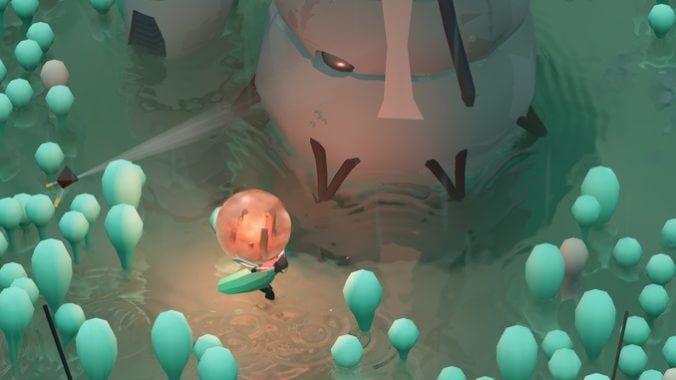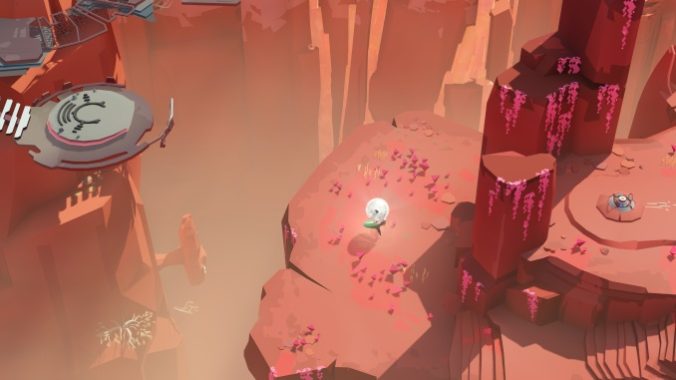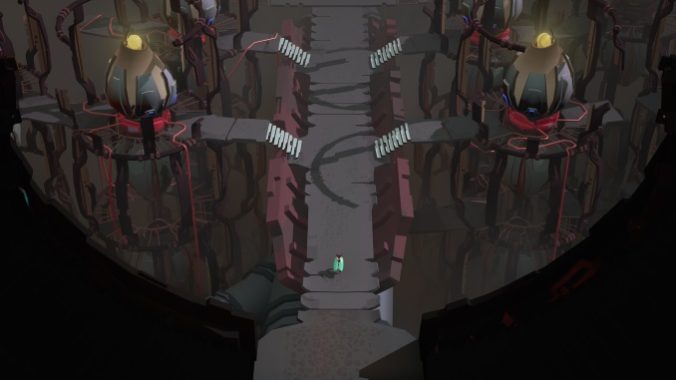
Surrounded by relics of unknown design, a little moth-person goes about their tasks. They travel through fleshy subterranean caverns, ochre cliffsides, and placid swamps, these disparate spaces connected by ancient technology and an overriding sense of purpose. Littered throughout are contraptions that block their progress until some discovery in a far-off place reveals the path forward. At first, you’re not sure why the protagonist does what they do, but an invisible hand guides their (and our) actions as we journey deeper into these unfathomable surroundings.
This is the world of Cocoon, a clever isometric puzzler that’s the freshman effort from indie outfit Geometric Interactive, founded by ex-Playdead (Limbo, Inside) employees Jeppe Carlsen and Jakob Schmid. Although their latest overlaps with their past work, particularly in its non-verbal storytelling and focus on atmospheric vistas, it finds its own identity through a focus on layered spaces that peel away to reveal ingenious puzzles and revelations.
A moment early on succinctly demonstrates its nested design and greater air of mystery. While exploring the canyons of its initial biome, you come across a metallic pad that looks out of place. You step on it, small plump tendrils unfurling as an audio cue implies it can be interfaced with. As you do, the moth-person is abruptly slingshotted out of their surroundings, copper mesas shrinking in a blink as they’re suddenly surrounded by metallic walls. Behind them is an orange orb. Is it a portal to where they came from? Or, somehow, is this object the totality of that place? This cosmic sense of scale, of worlds nestled inside of worlds, is a constant throughline here, and you guide the moth-person as they find new spheres and traverse the domains within.

Initially, the puzzles you come across are relatively simple. After a little bit of reflection, you’ll probably be able to piece together that you’re supposed to use the orb to move platforms or awaken dormant crab-like machines to aid you. These early stretches glide by in a psychedelic haze, and even if you’re unlikely to be stumped for long, these challenges are slick and seamless enough to remain satisfying. However, before long, things delve into truly brain-bending territory. As you find additional orbs and, with them, new environments, you start to work through these worlds in parallel, discoveries in one letting you progress in the rest. It takes what originally comes across as a cool engineering trick—the nonexistent load times as you hop in and out of the orbs—and turns it into the core design principle of the entire experience as you use the relationships between these globes to progress.
Some orbs grant traversal abilities, like how the orange one projects crystalline paths, but these powers can only be used when carrying that particular sphere. Because just one can be held at a time, you must store them carefully, sometimes placing them inside each other to circumvent these limitations as you travel back and forth. While this sounds potentially overwhelming, this puzzle box is so well-engineered that even as its trials become more daunting, it never feels inscrutable. Part of this extends from the exceedingly simple control scheme (you only use the joystick and a single button), but the greater reason is that the game is an excellent teacher.
Its lessons are taught in small digestible chunks, and even as it becomes increasingly tough, this process is gradual enough to avoid incomprehensibility. This is important because, out of context, the solutions to these challenges are downright diabolical, leading to gratifying eureka moments when things finally slide into place. And more than simply being fun to solve, unraveling these enigmas also ties into the general wonder embodied by its setting.
If it wasn’t clear from the previous descriptions, these environments hum with an otherwordly resonance. Each snow-globe realm you encounter is full of abandoned technology and forgotten statues that hint at some greater ritualistic significance to your travels. Bizarre flora and fauna complement these backdrops, translucent insects and floating pods creating the feeling we’re in a place beyond our understanding. The line between robotic creations and living creatures is often blurry, with organic technology that resembles a more adorable rendition of the pulsating machines found in much of Cronenberg’s material. All the while, the soundtrack weaves in and out of focus, blaring synths accompanying major discoveries (like when you find the first improbably massive door), but then receding into the background in favor of an ambient soundscape that accompanies much of the puzzle-solving.

Altogether, it creates the kind of transportive tone piece that videogames are so well-suited to realize. As much as Cocoon’s look may draw on the covers of pulp sci-novels and genre staples, most other mediums can’t get away with several consecutive hours of wordless exploration. For instance, recent films like Annihilation or Arrival are stories about the unknown, but they center human protagonists who actively talk through and attempt to understand what they’re witnessing. By contrast, here you play as a bipedal bug that hatches from an obelisk and never explicitly communicates. Your only direct interaction with anything that seems remotely sentient is in its brief boss fights (which are fun, by the way). This silence makes for a meditative trip that forces you to piece together the logic of this space and the beings that inhabit it on your own.
Beyond its visual strengths, one of this experience’s most fascinating aspects is how its mechanics amplify the mind-expanding qualities evoked by its aesthetics. Just as you’re getting a read on certain repetitive, game-y patterns, such as when a monster encounter or additional power are likely to materialize, things veer off course as the puzzles become increasingly interesting. As its challenges become more complex, they also become increasingly based around cosmic proportions, causing us to feel the odd metaphysics of this space slide around in our gray matter as we undergo a miniature metamorphosis. It’s a genuinely cool effect that feels like the underlying purpose of this endeavor.
If I have a major issue, it’s that just as this sensation is fully kicking in, this relatively brief journey comes to a close. The problem isn’t so much the game’s length but that it only reaches its full potential in this last hour or so as it bounds towards its climax. Also, while the ultimate conclusion doesn’t necessarily undermine what came before, it doesn’t quite elevate it either, as its fairly straightforward demonstration of what it’s all “about” is somewhat clumsy compared to what it more elegantly achieves through its mechanics. Still, even if it doesn’t entirely stick the landing, Cocoon’s mind-warping puzzles and well-realized setting make for an out-of-this-world experience.
Cocoon was developed by Geometric Interactive and published by Annapurna Interactive. Our review is based on the PC version. It’s also available on PlayStation, Xbox, and Switch.
Elijah Gonzalez is an assistant TV editor for Paste Magazine. In addition to watching the latest anime, he also loves videogames, movies, and creating large lists of media he’ll probably never actually get to. You can follow him on Twitter @eli_gonzalez11.